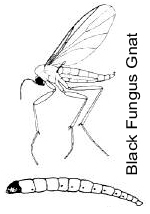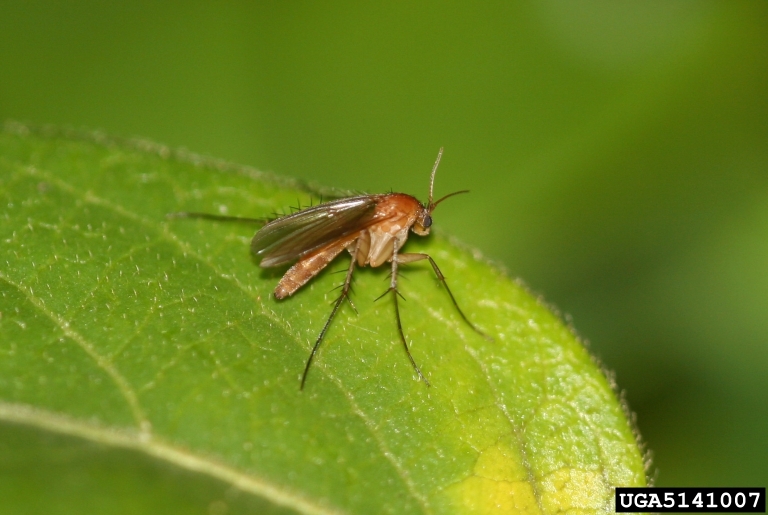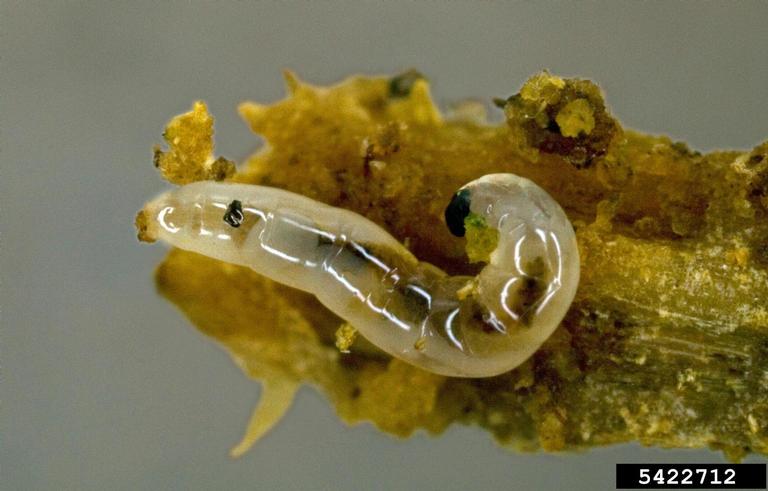 Managing Fungus Gnats - January 27, 2016 Jeff Schalau, Agent, Agriculture & Natural Resources University of Arizona Cooperative Extension, Yavapai County Fungus gnats are delicate, gray, dark-gray, or black mosquito-like insects about 1/10 to 1/8 inch long. You may see them on the soil in potted plants and other wet areas or hovering around lights and bright windows. The adults do not bite or damage plants and are usually considered a nuisance insect. They often appear at this time of year because we tend to over water our houseplants in the winter. This moist environment creates a perfect breeding ground for fungus gnats. The female fungus gnat lays between 100 to 300 eggs in batches of 2 to 30 each in decaying organic matter. Eggs are hardly visible without magnification and hatch within four to six days. Fungus gnat larvae often live in potted plants (potting soil is decaying organic matter). They are white, translucent maggots with shiny black heads and can reach 1/4 inch in length. Some species may also feed on plant roots and are known to injure the roots of bedding plants, African violets, carnations, cyclamens, geraniums, poinsettias and foliage plants. The larval stage lasts about 12 to 14 days. Plant symptoms may appear as sudden wilting, loss of vigor, poor growth, yellowing and foliage loss. Pupae are silk-like cocoons in the soil and adults emerge in five to six days. Simple prevention measures can minimize the chances of bringing these insects into your home. Inspect plants carefully before purchase for signs of insect infestation. Always use sterile potting soil to prevent introduction of fungus gnats. Overwatering, water leaks, algal growth, and poor drainage may result in buildup of fungus gnats. Allowing the soil to dry as much as possible between watering is effective in killing many larvae. Houseplants taken outside during warm weather may become infested with insects before being brought back indoors. Practice good sanitation and consider treating these plants before moving them back indoors. Management strategies include insecticides and repotting (or rerooting) infested plants. I do not recommend the use of chemical insecticides for fungus gnats in the home. Fungus gnats are considered a nuisance pest and not usually that plentiful in our arid environment. Yellow sticky cards attract fungus gnats and are often used for monitoring. Placement of several yellow sticky cards may also be somewhat effective in reducing their numbers. The yellow color attracts gnats and they get stuck to the card. Electrocutor-light fly traps will attract and kill adult fungus gnats at night. Bacillus thuringiensis serotype israelensis (Bti) is a biological control that can be used to manage fungus gnats. It is a safer alternative to chemicals and is applied to the soil of infested plants to control larvae. This product is packaged for homeowners and sold as Gnatrol. Other biological controls are available for fungus gnat management. Beneficial nematodes can be purchased that parasitize fungus gnat larvae. These microscopic roundworms are available from specialty garden catalogs. Steinernema feltiae is the nematode species that is most effective against fungus gnats and it is sold under the trade names Nemasys, NemAttack, Enton-em, X-Gnat, and Magnet. Applications of these nematodes have eliminated fungus gnats from the houseplants in our offices. Additional fungus gnat information and photos are included below. Before you launch a control campaign for any pest, remember the four steps of integrated pest management (IPM). These are: 1) correct identification of pest; 2) monitor for damage (or nuisance) threshold; 3) once the threshold is reached, apply multiple prevention and control measures; and 4) monitor for control effectiveness and revise strategy if needed. IPM is a standard approach for minimizing damage from any pest species. All gardeners would do well to memorize these steps and use them whenever pest issues arise. The key points are correct pest species identification and accepting some damage before control measures are applied. If you jump the gun and apply pesticides before a damage threshold is reached, you will most certainly kill some beneficial (predators and parasites) and/or benign insects. Naming of companies or products is neither meant to imply endorsement by the author nor criticism of similar companies or products not mentioned. Follow the Backyard Gardener on Twitter – use the link on the BYG website. If you have other gardening questions, call the Master Gardener help line in the Camp Verde office at 928-554-8992 or e-mail us at verdevalleymg@gmail.com and be sure to include your name, address and phone number. Find past Backyard Gardener columns or provide feedback at the Backyard Gardener web site: http://cals.arizona.edu/yavapai/anr/hort/byg/. Photos  Adult fungus gnat (Johnny N. Dell, Bugwood.org).  Fungus gnat larva (David Cappaert, Michigan State University, Bugwood.org). Additional Resources Fungus Gnat Integrated Pest Management University of Arizona Cooperative Extension extension.arizona.edu/pubs/az1531.pdf Fungus Gnats University of California Agriculture and Natural Resources www.ipm.ucdavis.edu/PMG/PESTNOTES/pn7448.html Fungus Gnats as Houseplant and Indoor Pests Colorado State University extension.colostate.edu/topic-areas/insects/fungus-gnats-as-houseplant-and-indoor-pests-5-584/ |